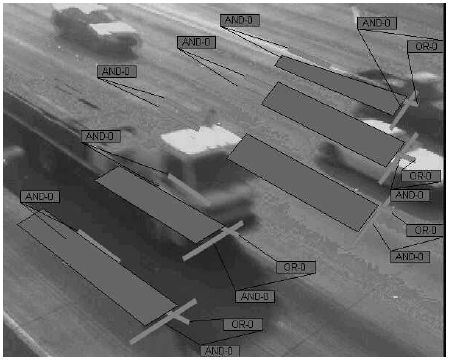Publication Number: FHWA-HRT-06-139 Date: October 2006 Traffic Detector Handbook:Third Edition—Volume II CHAPTER 5. SENSOR-INSTALLATION TECHNIQUES (continued) INSTALLATION OF TWO-AXIS FLUXGATE MAGNETOMETERS Representative fluxgate magnetometer installations for various lane configurations are illustrated in Figure 5-53. The probes are buried beneath the roadway surface in cored holes. The optimum depth and placement of the probes depends on the type of detection required (see and ) and the size of the probes. After the preinstallation activities (described earlier in this chapter) have been completed, installation usually follows the step-by-step procedures discussed below. Fluxgate magnetometer installations for various lane configurations. INSTALLATION OF SENSING PROBE After securing the work zone with appropriate barricades, cones, etc., to divert traffic from the area, the first step is to layout and mark the detection area with spray paint or chalk markers to match the construction plans.
Get reviews from RTMS - Oilfield Rental Tool Management Software users. RTMS is designed to be used by field personnel. RTMS allows users to Rent, Sell.
Bose clock radio. The apps require the latest stable Chrome browser to run. Google Drive, Google Keep, and Feedly are three I have tried. They are in effect a first step to creating a Chrome operating system on your Windows desktop. More information is at the and Get your own favorite tip published! The apps can be downloaded individually from the Chrome Web store. There are not all that many available yet but more are being developed.

A magnetic field analyzer should be placed over each marked probe location to verify that the area is free of ferrous metal objects that would degrade performance as discussed in. Holes for the probes are subsequently drilled through the roadway to the proper depth as defined in the construction plans.

The general rule for the diameter of the hole is to use the diameter of the sensing probe plus 1/8-inch (3.2 mm). Slots for the connecting cable are then sawed in the pavement to the adjacent pull box and blown clean and dry with compressed air. The pull box is installed using the same procedures as previously described for loop detectors. Windows xp sp3 2010 all oem original iso download full. The probe should be installed with the long dimension vertical and with the cable ends at the top. The probe should be firmly supported in the hole so it will not shift from its vertical position. There are several approaches for placement of the probe in the hole. Manufacturers indicate that the probe is made so that it can be placed in the hole without any protective housing and a number of agencies follow this procedure.
Other agencies prefer to provide some type of housing (e.g., PVC conduit) for placing the probe, while others choose to secure the probe by tightly packing sand or using sealant around it. A representative standard plan for magnetometer installation is shown in Figure 5-54.
Standard plan for fluxgate magnetometer installation. The cables from the probe to the pull box are installed in the sawed slot. A 3/16- to 1/4-in (4.8- to 6.4-mm) wood paddle is used to seat the cable in the sawed slot.
A 5-ft (1.5-m) length of extra cable should be left at the pull box. The cables should be identified by lane or by probe designation. A volt–ohmmeter should be used to verify the series resistance (continuity) of the probe and cable. This value should be the resistance of each probe (4 to 6 ohms per probe) plus the resistance of the cable. The value should be within 10 percent of the calculated value. Resistance to ground should also be checked.
The value should be high, indicating that there are no breaks in the probe or wire insulation. A megger should not be used to check resistance to ground, as the large value of induced voltage will destroy the probe. SPLICING THE CABLES Splicing of the sensing element cable to the lead-in cables to the controller cabinet should be soldered using resin core solder. The techniques for splicing are the same as those used for inductive-loop detectors. The lead-in cable should not be spliced between the pull box and the controller cabinet. The same precautions identified for loop detectors should be addressed when installing magnetometers. Two types of heat-shrinkable polyolefin tubing are used for splicing probe cables to the lead-in (home-run) cable—small diameter tubes insulate the individual conductors and a single large tube seals and protects the splice.